A Comparison between One-Step and Two-Step Nesting Strategy in the Dynamical Downscaling of Regional Climate Model COSMO-CLM at 2.2 km Driven by ERA5 Reanalysis
Abstract
1. Introduction
- may the dynamical downscaling of ERA5 reproduce past precipitation dynamics reliably and coherently?
- at what extent may the direct nesting strategy performances be adequately for the scope in hand?
2. Materials and Methods
2.1. Climate Experiments
2.2. Reference Datasets
2.2.1. Observational Datasets
- E-OBS [43,54]: it is a daily gridded land-only observational dataset over Europe at a horizontal resolution of 0.1° (~11 km). It contains data for precipitation amount, mean/maximum/minimum temperature, sea level pressure, and surface shortwave downwelling radiation. Its latest version (v.21) delivered by Copernicus Climate Data Store covers the period 1950–2019. As general information, the E-OBS relies on the “blended” time series from the station network of the European Climate Assessment & Dataset (ECA&D) project. It is calculated following a two-stage process to derive the daily field and the uncertainty in these daily estimates. The limitations due to the interpolation method are the underestimation (typically 10–20%) of high intensities (smoothing effect) and overestimation at low intensities (moist extension into dry areas), while systematic errors are more substantial for convective rainfall [17,55].
- RADKLIM-RW [44]: it is a radar-based dataset for Germany (region of 1100 km × 900 km), available at the DWD Open Data Portal, at a horizontal resolution of 1 km. It provides hourly precipitation adjusted to rain gauge measurements. RADKLIM-RW represents a reanalysed and temporally extended version of RADOLAN-RW. It relies on consistent processing techniques, new correction algorithms (e.g., for distance- and height-dependent signal reduction and for spokes) and more rain gauges for adjustment. The dataset currently covers the period of 2001 to 2017.
2.2.2. Existing Reanalysis Dataset
- ERA5-Land [33]: it is an hourly land-only ERA5-driven reanalysis. It gives a consistent view of the land variables evolution from 1981 onwards at an enhanced horizontal resolution (~9 km) compared to ERA5. ERA5-Land is essentially an offline simulation of the ERA5 surface scheme with improved forcing, making it computationally affordable for relatively quick updates. Despite its resolution is enhanced with respect to ERA5, ERA5-Land does not derive from a dynamical downscaling, then precipitation should not be much improved.
- UERRA (MESCAN-SURFEX option) [34,56]: it is a reanalysis at ~5.5 km providing estimations of the climate in Europe from 1961 to 2019 at 00, 06, 12, and 18 UTC. It descends from the UERRA-HARMONIE, a reanalysis (~11 km) based on a 3-D data assimilation system assuming along the lateral borders data from ERA40 for the years before 1979, and ERA-Interim for the years until 2019. Operatively, it combines the UERRA-HARMONIE with the MESCAN system and the land surface platform SURFEX to derive daily accumulated precipitation. To this aim, additional surface observations are considered.
2.3. Levels of Analysis
- first level of analysis (i.e., evaluation at areal scale): it is designed to provide a general areal overview about the performances of the CCLM002-Direct and CCLM002-Nest with respect to E-OBS and existing reanalysis products (i.e., ERA5-Land and UERRA); such a first screening is performed considering spatial statistics over 2007–2011 on the evaluation domain shown in Figure 3;
- second level of analysis (i.e., evaluation at city scale): it serves as a base to understand the potentiality of CCLM002-Direct and CCLM002-Nest with respect to E-OBS and existing reanalysis products (i.e., ERA5-Land and UERRA), in describing precipitation features at city scale; such an evaluation is performed at monthly scale on the city of Paris (France, Lon = 1.95° E–2.75° E; Lat = 48.5° N–49.25° N), and Cologne (Germany, Lon = 6.5° E–7.5° E; Lat = 50.75° N–51.25° N) (Figure 3b);
- third level of analysis (i.e., evaluation at event scale): it aims at evaluating the ability of CCLM002-Direct and CCLM002-Nest in reproducing spatial precipitation patterns at the scale of event; to this aim, two summer precipitation events, occurred over the evaluation domain of Figure 3 in August 2007 and August 2010 are analyzed using RADKLIM-RW data as reference.
2.4. Statistical Tools
3. Results
3.1. First Level of Analysis: Evaluation at Areal Scale
3.2. Second Level of Analysis: Evaluation at City Scale
3.3. Third Level of Analysis: Evaluation at sCale of Event
4. Discussion and Conclusions
Author Contributions
Funding
Data Availability Statement
Acknowledgments
Conflicts of Interest
References
- Sillmann, J.; Thorarinsdottir, T.; Keenlyside, N.; Schaller, N.; Alexander, L.V.; Hegerl, G.; Seneviratne, S.I.; Vautard, R.; Zhang, X.; Zwiers, F.W. Understanding, modeling and predicting weather and climate extremes: Challenges and opportunities. Weather Clim. Extrem. 2017, 18, 65–74. [Google Scholar] [CrossRef]
- Robock, A.; Turco, R.; Harwell, M.; Ackerman, T.P.; Andressen, R.; Chang, H.S.; Sivakumar, M.V.K. Use of general circulation model output in the creation of climate change scenarios for impact analysis. Clim. Chang. 1993, 23, 293–335. [Google Scholar] [CrossRef]
- Giorgi, F.; Jones, C.; Asrar, G.R. Addressing Climate Information Needs at the Regional Level: The CORDEX Framework. World Meteorol. Organ. Bull. 2009, 58, 175–183. [Google Scholar]
- Fowler, H.J.; Blenkinsop, S.; Tebaldi, C. Linking climate change modelling to impacts studies: Recent advances in downscaling techniques for hydrological modelling. Int. J. Climatol. 2007, 27, 1547–1578. [Google Scholar] [CrossRef]
- Reder, A.; Rianna, G.; Vezzoli, R.; Mercogliano, P. Assessment of possible impacts of climate change on the hydrological regimes of different regions in China. Adv. Clim. Chang. Res. 2016, 7, 169–184. [Google Scholar] [CrossRef]
- Rianna, G.; Reder, A.; Pagano, L.; Mercogliano, P. Assessing future variations in landslide occurrence due to climate changes: Insights from an Italian test case. In Geotechnical Research for Land Protection and Development: Proceedings of CNRIG 2019; Calvetti, F., Cotecchia, F., Galli, A., Jommi, C., Eds.; Springer International Publishing: New York, NY, USA, 2020; Volume 40, pp. 255–264. [Google Scholar] [CrossRef]
- Adinolfi, M.; Rianna, G.; Mercogliano, P.; Maiorano, R.M.S.; Aversa, S. Behaviour of energy piles under climate-change scenarios: A case study in Southern Italy. Environ. Geotech. 2020, 4, 1–15. [Google Scholar] [CrossRef]
- Cucchi, M.; Weedon, G.P.; Amici, A.; Bellouin, N.; Lange, S.; Schmied, H.M.; Hersbach, H.; Buontempo, C. WFDE5: Bias Adjusted ERA5 Reanalysis Data for Impact Studies. Earth Syst. Sci. Data 2020, 12, 2097–2120. [Google Scholar] [CrossRef]
- Hackenbruch, J.; Schadler, G.; Schipper, J.W. Added value of high-resolution regional climate simulations for regional impact studies. Meteorol. Z. 2016, 25, 291–304. [Google Scholar] [CrossRef]
- Mearns, L.O.; Lettenmaier, D.P.; McGinnis, S. Uses of results of regional climate model experiments for impacts and adaptation studies: The example of NARCCAP. Curr. Clim. Chang. Rep. 2015, 1, 1–9. [Google Scholar] [CrossRef]
- Reder, A.; Rianna, G. Exploring ERA5 reanalysis potentialities for supporting landslide investigations: A test case from Campania Region (Southern Italy). Landslides 2021. [Google Scholar] [CrossRef]
- Montesarchio, M.; Zollo, A.L.; Bucchignani, E.; Mercogliano, P.; Castellari, S. Performance evaluation of high-resolution regional climate simulations in the Alpine space and analysis of extreme events. J. Geophys. Res. Atmos. 2014, 119, 3222–3237. [Google Scholar] [CrossRef]
- Dosio, A.; Panitz, H.J.; Schubert-Frisius, M.; Luthi, D. Dynamical downscaling of CMIP5 global circulation models over CORDEX-Africa with COSMO-CLM: Evaluation over the present climate and analysis of the added value. Clim. Dyn. 2015, 44, 2637–2661. [Google Scholar] [CrossRef]
- Feldmann, H.; Früh, B.; Schädler, G.; Panitz, H.J.; Keuler, K.; Jacob, D.; Lorenz, P. Evaluation of the precipitation for South-western Germany from high resolution simulations with regional climate models. Meteorol. Z. 2008, 17, 455–465. [Google Scholar] [CrossRef]
- Hersbach, H.; Bell, B.; Berrisford, P.; Hirahara, S. The ERA5 global reanalysis. Q. J. R. Meteorol. Soc. 2020, 146, 1999–2049. [Google Scholar] [CrossRef]
- Dee, D.P.; Uppala, S.M.; Simmons, A.J.; Berrisford, P.; Poli, P.; Kobayashi, S.; Andrae, U.; Balmaseda, M.A.; Balsamo, G.; Bauer, P.; et al. The ERA-Interim reanalysis: Configuration and performance of the data assimilation system. Q. J. R. Meteorol. Soc. 2011, 137, 553–597. [Google Scholar] [CrossRef]
- Ban, N.; Schmidli, J.; Schär, C. Evaluation of the new convective-resolving regional climate modelling approach in decade-long simulations. J. Geophys. Res. Atmos. 2014, 119, 7889–7907. [Google Scholar] [CrossRef]
- Berthou, S.; Kendon, E.J.; Chan, S.C.; Ban, N.; Leutwyler, D.; Schär, C.; Fosser, G. Pan-European climate at convection-permitting scale: A model intercomparison study. Clim. Dyn. 2018, 5, 1–25. [Google Scholar] [CrossRef]
- Coppola, E.; Sobolowski, S.; Pichelli, E.; Raffaele, F.; Ahrens, B.; Anders, I.; Ban, N.; Bastin, S.; Belda, M.; Belusic, D.; et al. A first-of-its-kind multi-model convection permitting ensemble for investigating convective phenomena over Europe and the Mediterranean. Clim. Dyn. 2020, 55, 3–34. [Google Scholar] [CrossRef]
- Fumière, Q.; Déqué, M.; Nuissier, O.; Somot, S.; Alias, A.; Caillaud, C.; Laurantin, O.; Seity, Y. Extreme rainfall in Mediterranean France during the fall: Added-value of the CNRM-AROME convection permitting regional climate model. Clim. Dyn. 2020, 55, 77–91. [Google Scholar] [CrossRef]
- Feldmann, H.; Schädler, G.; Panitz, H.J.; Kottmeier, C. Near future changes of mean and extreme precipitation derived from an ensemble of high-resolution RCM simulations. Int. J. Climatol. 2013, 33, 1964–1977. [Google Scholar] [CrossRef]
- Ehmele, F.; Kautz, L.A.; Feldmann, H.; Pinto, J.G. Long-term variance of heavy precipitation across central Europe using a large ensemble of regional climate model simulations. Earth Syst. Dyn. 2020, 11, 469–490. [Google Scholar] [CrossRef]
- Adinolfi, M.; Raffa, M.; Reder, A.; Mercogliano, P. Evaluation and Expected Changes of Summer Precipitation at Convection Permitting Scale with COSMO-CLM over Alpine Space. Atmosphere 2021, 12, 54. [Google Scholar] [CrossRef]
- Reder, A.; Raffa, M.; Montesarchio, M.; Mercogliano, P. Performance evaluation of regional climate model simulations at different spatial and temporal scales over the complex orography area of the Alpine region. Nat. Hazards. 2020, 102, 151–177. [Google Scholar] [CrossRef]
- Chan, S.C.; Kendon, E.J.; Fowler, H.J.; Blenkinsop, S.; Ferro, C.A.T.; Stephenson, D.B. Does increasing the spatial resolution of a regional climate model improve the simulated daily precipitation? Clim. Dyn. 2013, 41, 1475–1495. [Google Scholar] [CrossRef]
- Fosser, G.; Khodayar, S.; Berg, P. Benefit of convection permitting climate model simulations in the representation of convective precipitation. Clim. Dyn. 2015, 44, 45–60. [Google Scholar] [CrossRef]
- Pilon, R.; Zhang, C.; Dudhia, J. Roles of deep and shallow convection and microphysics in the MJO simulated by the Model for Prediction Across Scales. J. Geophys. Res. Atmos. 2016, 121, 10575–10600. [Google Scholar] [CrossRef]
- Prein, A.F.; Langhans, W.; Fosser, G.; Ferrone, A.; Ban, N.; Goergen, K.; Keller, M.; Tolle, M.; Gutjahr, O.; Feser, F.; et al. A review on regional convection-permitting climate modeling: Demonstrations, prospects, and challenges. Rev. Geophys. 2015, 53, 323–361. [Google Scholar] [CrossRef]
- Piazza, M.; Prein, A.; Truhetz, H.; Csaki, A. On the sensitivity of precipitation in convection-permitting climate simulations in the Eastern Alpine region. Meteorol. Z. 2019, 28, 323–346. [Google Scholar] [CrossRef]
- Reder, A.; Rianna, G.; Mercogliano, P.; Castellari, S. Parametric investigation of Urban Heat Island dynamics through TEB 1D model for a case study: Assessment of adaptation measures. Sustain. Cities Soc. 2018, 39, 662–673. [Google Scholar] [CrossRef]
- Sugawara, H.; Oda, R.; Seino, N. Urban Thermal Influence on the Background Environment of Convective Precipitation. J. Meteorol. Soc. Jpn. 2018, 96, 67–76. [Google Scholar] [CrossRef]
- COSMO-REA6. Available online: https://reanalysis.meteo.uni-bonn.de/?COSMO-REA6 (accessed on 23 December 2020).
- Muñoz Sabater, J. ERA5-Land Hourly Data from 1981 to Present. Copernicus Climate Change Service (C3S) Climate Data Store (CDS) 2019. Available online: https://cds.climate.copernicus.eu/cdsapp#!/dataset/reanalysis-era5-land?tab=overview (accessed on 23 December 2020).
- Ridal, M.; Olsson, E.; Unden, P.; Zimmermann, K.; Ohlsson, A. Uncertainties in Ensembles of Regional Re-Analyses. Deliverable D2.7 HARMONIE Reanalysis Report of Results and Dataset 2017. Available online: http://www.uerra.eu/component/dpattachments/?task=attachment.download&id=296 (accessed on 23 December 2020).
- Beck, A.; Ahrens, B.; Stadlbacher, K. Impact of nesting strategies on precipitation forecasting in dynamical downscaling of reanalysis data. Geophys. Res. Lett. 2004, 31, 19. [Google Scholar] [CrossRef]
- Brisson, E.; Demuzere, M.; van Lipzig, N.P.M. Modelling strategies for performing convection-permitting climate simulations. Meteorol. Z. 2016, 25, 149–163. [Google Scholar] [CrossRef]
- Matte, D.; Laprise, R.; Thériault, J.M. Comparison between high-resolution climate simulations using single-and double-nesting approaches within the Big-Brother experimental protocol. Clim. Dyn. 2016, 47, 3613–3626. [Google Scholar] [CrossRef]
- Tölle, M.H.; Schefczyk, L.; Gutjahr, O. Scale dependency of regional climate modeling of current and future climate extremes in Germany. Theor. Appl. Climatol. 2018, 134, 829–848. [Google Scholar] [CrossRef]
- Marsigli, C.; Montani, A.; Paccagnella, T. Provision of boundary conditions for a convection-permitting ensemble: Comparison of two different approaches. Nonlinear. Process. Geophys. 2014, 21, 393–403. [Google Scholar] [CrossRef][Green Version]
- Klasa, C.; Arpagaus, M.; Walser, A.; Wernli, H. An evaluation of the convection-permitting ensemble COSMO-E for three contrasting precipitation events in Switzerland. Quart. J. Roy. Meteor. Soc. 2018, 144, 744–764. [Google Scholar] [CrossRef]
- Rockel, B.; Will, A.; Hence, A. The regional climate model COSMO-CLM (CCLM). Meteorol. Z. 2008, 17, 347–348. [Google Scholar] [CrossRef]
- Wouters, H.; Demuzere, M.; Blahak, U.; Fortuniak, K.; Maiheu, B.; Camps, J.; Tielemans, D.; van Lipzig, N.P.M. The efficient urban canopy dependency parametrization (SURY) v1.0 for atmospheric modelling: Description and application with the COSMO-CLM model for a Belgian summer. Geosci. Model. Dev. 2016, 9, 3027–3054. [Google Scholar] [CrossRef]
- Cornes, R.; van der Schrier, G.; van den Besselaar, E.J.M.; Jones, P.D. An ensemble version of the E-OBS temperature and precipitation datasets. J. Geophys. Res. Atmos. 2018, 123, 9391–9409. [Google Scholar] [CrossRef]
- Winterrath, T.; Brendel, C.; Hafer, M.; Junghänel, T.; Klameth, A.; Lengfeld, K.; Walawender, E.; Weigl, E.; Becker, A. RADKLIM Version 2017.002: Reprocessed gauge-adjusted radar data, one-hour precipitation sums (RW). Dtsch. Wetterd. 2018, 2. [Google Scholar] [CrossRef]
- Bucchignani, E.; Cattaneo, L.; Panitz, H.J.; Mercogliano, P. Sensitivity analysis with the regional climate model COSMO-CLM over the CORDEX-MENA domain. Meteorol. Atmos. Phys. 2016, 128, 73–95. [Google Scholar] [CrossRef]
- Giorgi, F.; Gutowski, W.J. Regional dynamical downscaling and the CORDEX initiative. Annu. Rev. Environ. Resour. 2015, 40, 467–490. [Google Scholar] [CrossRef]
- Jacob, D.; Petersen, J.; Eggert, B.; Alias, A.; Christensen, O.B.; Bouwer, L.M.; Braun, A.; Colette, A.; Deque, M.; Georgievski, G.; et al. EURO-CORDEX: New high-resolution climate change projections for European impact research. Reg. Environ. Chang. 2014, 14, 563–578. [Google Scholar] [CrossRef]
- Ritter, B.; Geleyn, J.F. A comprehensive radiation scheme for numerical weather prediction models with potential applications in climate simulations. Mon. Weather Rev. 1992, 120, 303–325. [Google Scholar] [CrossRef]
- Tiedtke, M. A comprehensive mass flux scheme for cumulus parameterization in large-scale models. Mon. Weather Rev. 1989, 117, 1779–1800. [Google Scholar] [CrossRef]
- Doms, G.; Forstner, J.; Heise, E.; Herzog, H.J.; Mironov, D.; Raschendorfer, T.; Reinhardt, T.; Ritter, B.; Schrodin, R.; Schulz, J.P.; et al. A Description of the Non-Hydrostatic Regional COSMO Model. Part-II: Physical Parameterization. 2011. Available online: https://klimanavigator.eu/imperia/md/content/csc/klimanavigator/cosmophysparamtr.pdf (accessed on 23 December 2020).
- Baldauf, M.; Schulz, J.P. Prognostic Precipitation in the Lokal Modell (LM) of DWD. COSMO Newsletter No. 4.; Deutscher Wetterdienst: Offenbach am Main, Germany, 2004; pp. 177–180. [Google Scholar]
- Joint Research Centre. Global land Cover 2000 Database, European Commission. Joint Research Centre 2003. Available online: https://forobs.jrc.ec.europa.eu/products/glc2000/glc2000.php (accessed on 23 December 2020).
- Mellor, G.L.; Yamada, T. A hierarchy of turbulence closure models for planetary boundary layers. J. Atmos. Sci. 1974, 31, 1791–1806. [Google Scholar] [CrossRef]
- Haylock, M.R.; Hofstra, N.; Klein Tank, A.M.G.; Klok, E.J.; Jones, P.D.; New, M. A European daily high-resolution gridded data set of surface temperature and precipitation for 1950–2006. J. Geophys. Res. Atm. 2008, 113. [Google Scholar] [CrossRef]
- Isotta, F.A.; Frei, C.; Weilguni, V.; Perčec Tadić, M.; Lassegues, P.; Rudolf, B.; Pavan, V.; Cacciamani, C.; Antolini, G.; Ratto, S.M.; et al. The climate of daily precipitation in the Alps: Development and analysis of a high-resolution grid dataset from pan-Alpine rain-gauge data. Int. J. Clim. 2014, 34, 1657–1675. [Google Scholar] [CrossRef]
- Bazile, E.; Abida, R.; Verelle, A.; Le Moigne, P.; Szczypta, C. MESCAN-SURFEX Surface Analysis. Deliverable D2.8 of the UERRA Project 2017. Available online: http://www.uerra.eu/publications/deliverable-reports.html (accessed on 23 December 2020).
- ETCCDI Climate Change Indices. Available online: http://etccdi.pacificclimate.org/list_27_indices.shtml. (accessed on 14 February 2021).
- Taylor, K.E. Summarizing multiple aspects of model performance in a single diagram. J. Geophys. Res. 2001, 106, 7183–7192. [Google Scholar] [CrossRef]
- Soares, P.M.M.; Cardoso, R.M. A simple method to assess the added value using high-resolution climate distributions: Application to the EURO-CORDEX daily precipitation. Int. J. Climatol. 2017, 38, 1484–1498. [Google Scholar] [CrossRef]
- Gupta, H.V.; Kling, H.; Yilmaz, K.K.; Martinez, G.F. Decomposition of the mean squared error and NSE performance criteria: Implications for improving hydrological modelling. J. Hydrol. 2009, 377, 80–91. [Google Scholar] [CrossRef]
- Knoben, W.J.M.; Freer, J.E.; Woods, R.A. Technical note: Inherent benchmark or not? Comparing Nash–Sutcliffe and Kling–Gupta efficiency scores. Hydrol. Earth Syst. Sci. 2019, 23, 4323–4331. [Google Scholar] [CrossRef]
- Lucas-Picher, P.; Boberg, F.; Christensen, J.H.; Berg, P. Dynamical downscaling with reinitializations: A method to generate finescale climate datasets suitable for impact studies. J. Hydrometeorol. 2013, 14, 1159–1174. [Google Scholar] [CrossRef]
- Prein, A.F.; Gobiet, A. Impacts of uncertainties in European gridded precipitation observations on regional climate analysis. Int. J. Climatol. 2017, 37, 305–327. [Google Scholar] [CrossRef] [PubMed]
- Vidal, J.P.; Martin, E.; Franchistéguy, L.; Baillon, M.; Soubeyroux, J.M. A 50-year high-resolution atmospheric reanalysis over France with the Safran system. Int. J. Climatol. 2010, 30, 1627–1644. [Google Scholar] [CrossRef]
- Pelosi, A.; Terribile, F.; D’Urso, G.; Chirico, G.B. Comparison of ERA5-Land and UERRA MESCAN-SURFEX Reanalysis Data with Spatially Interpolated Weather Observations for the Regional Assessment of Reference Evapotranspiration. Water 2020, 12, 1669. [Google Scholar] [CrossRef]
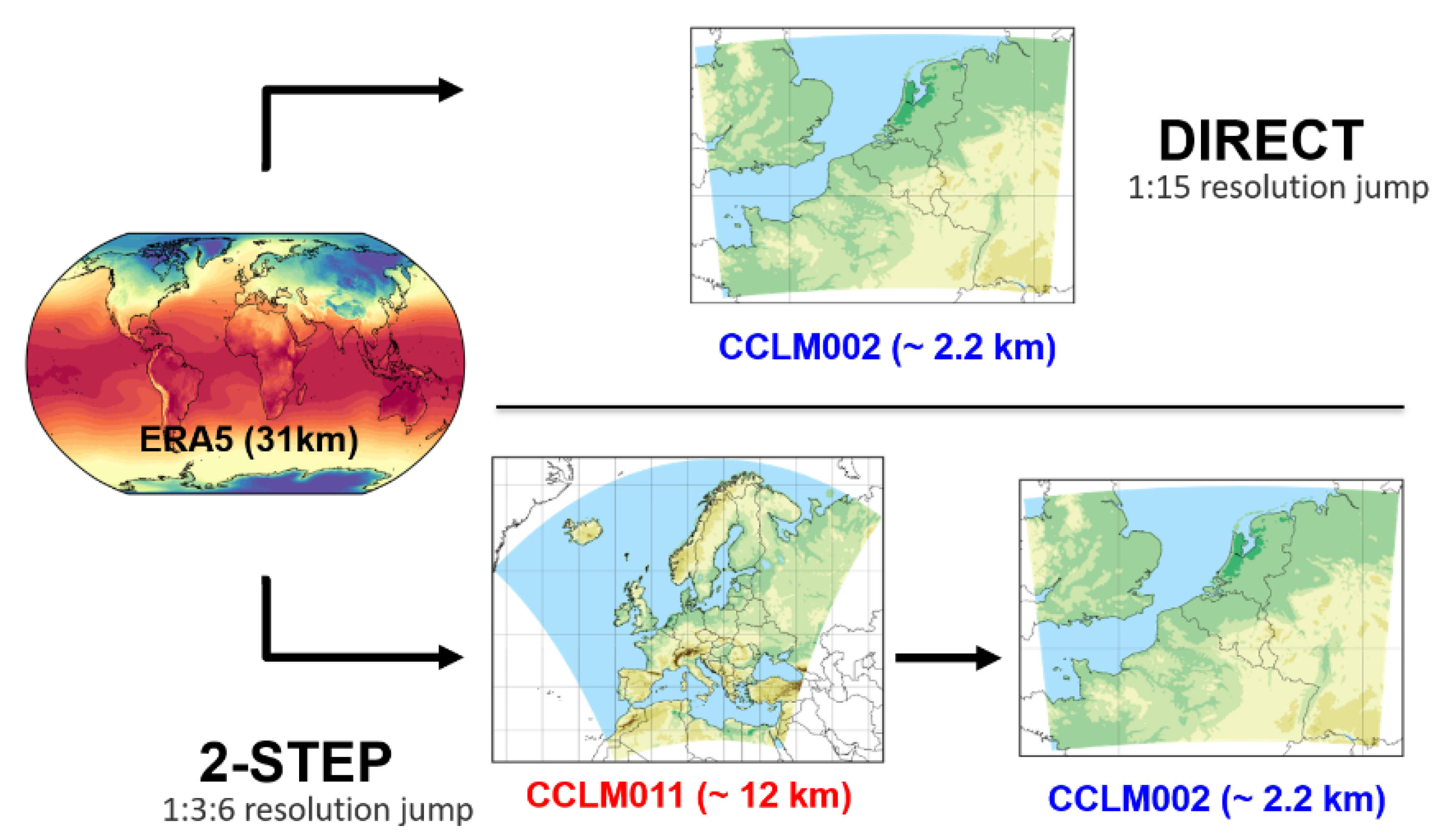
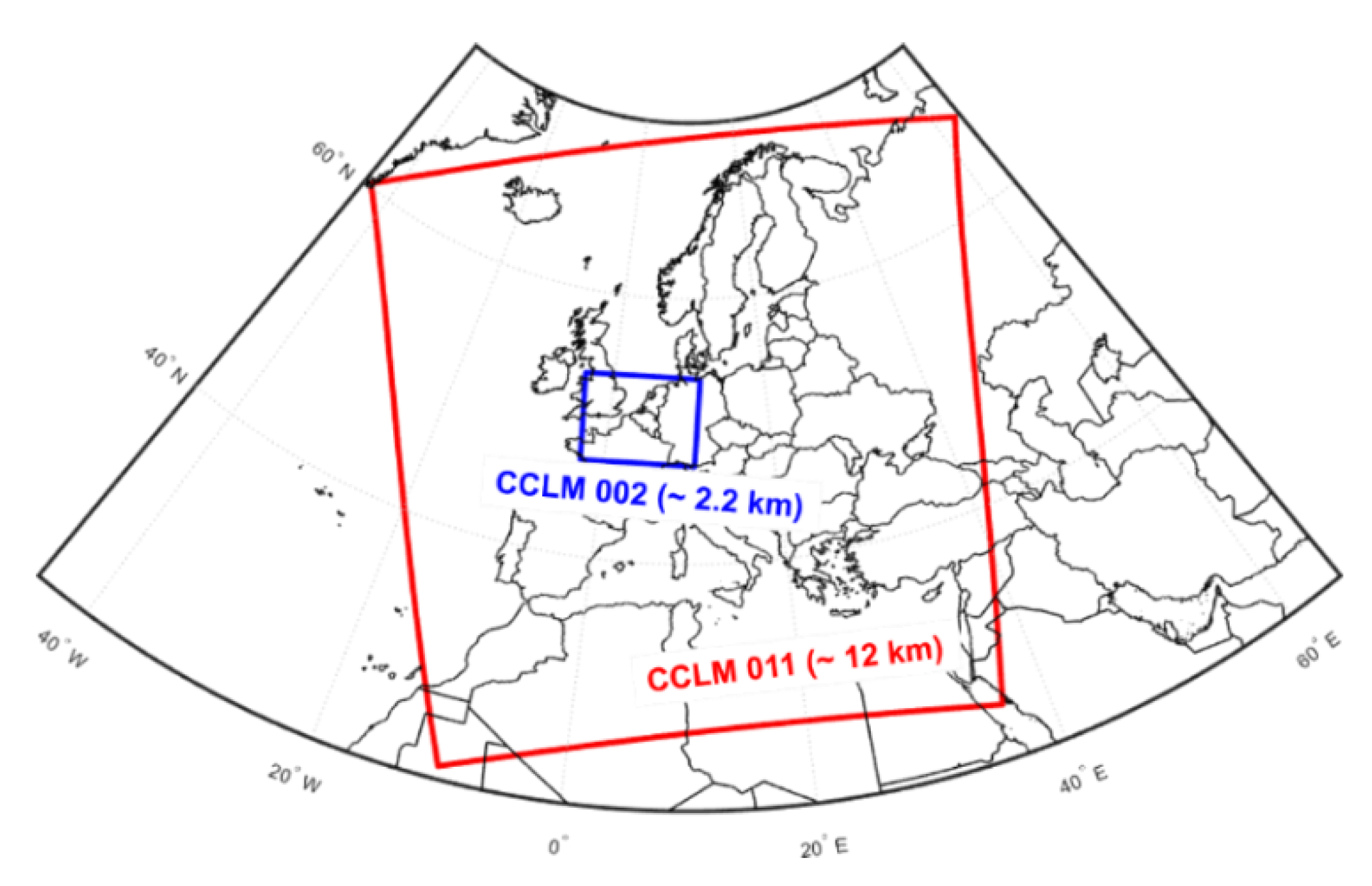
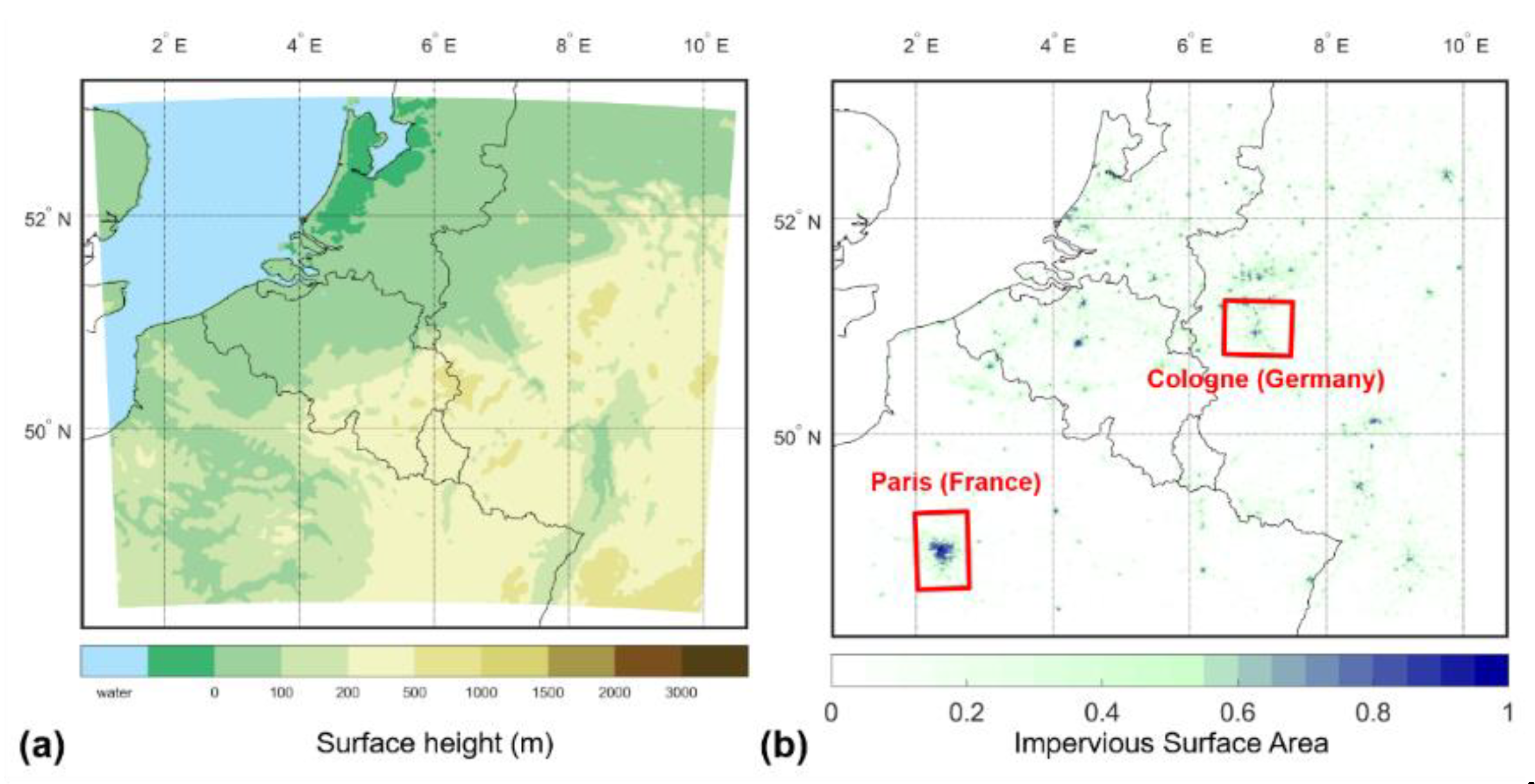
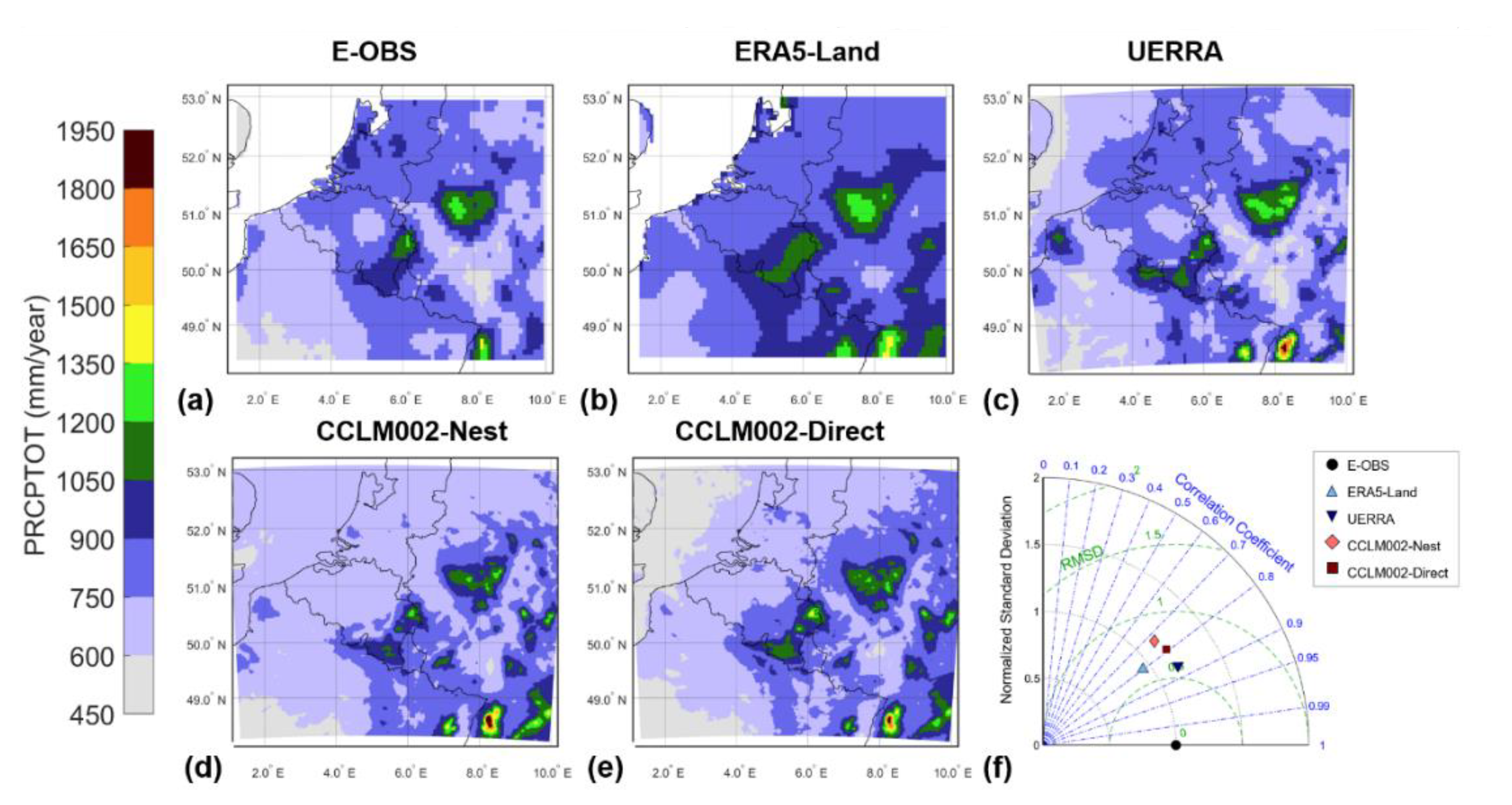
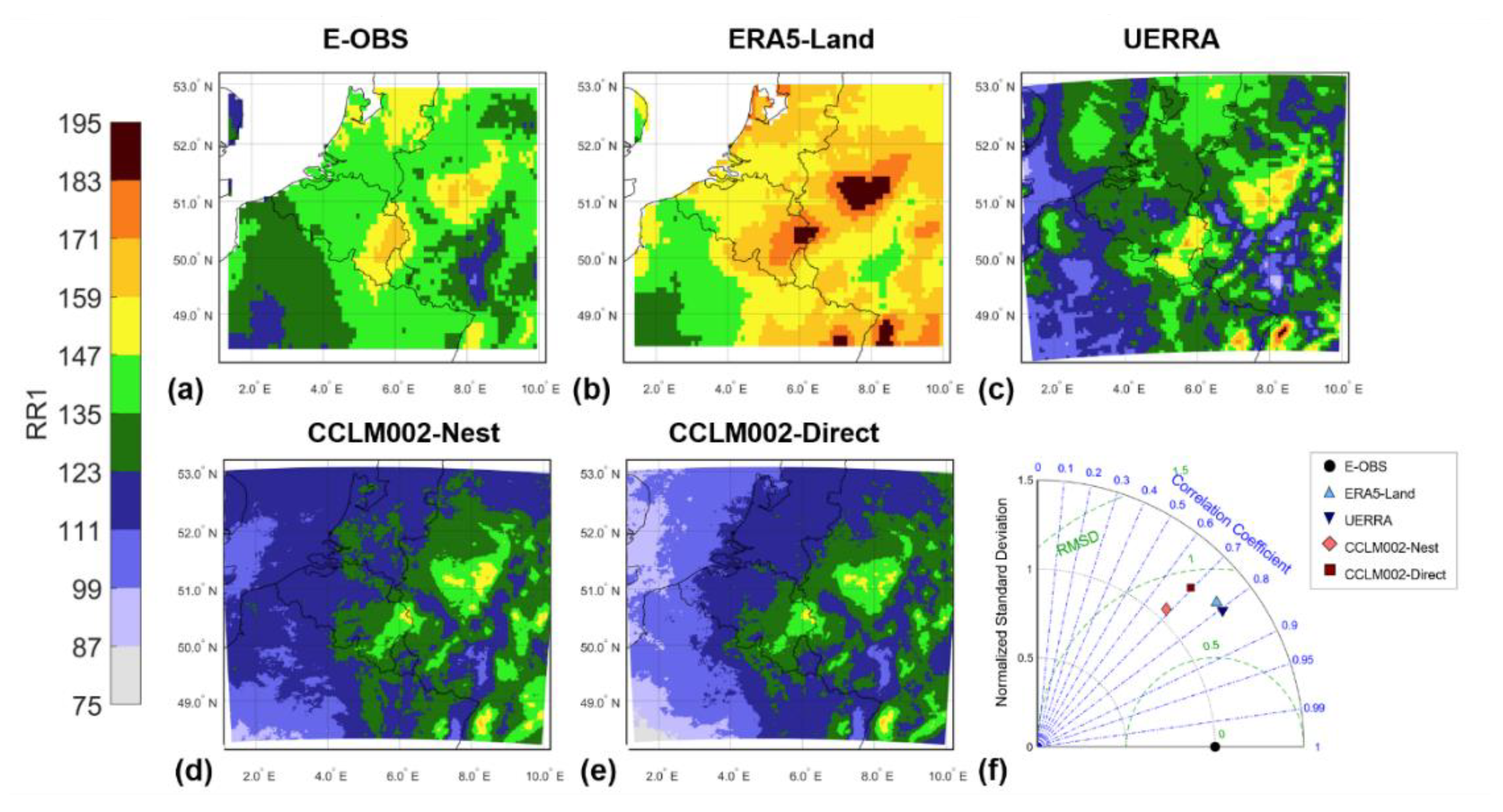
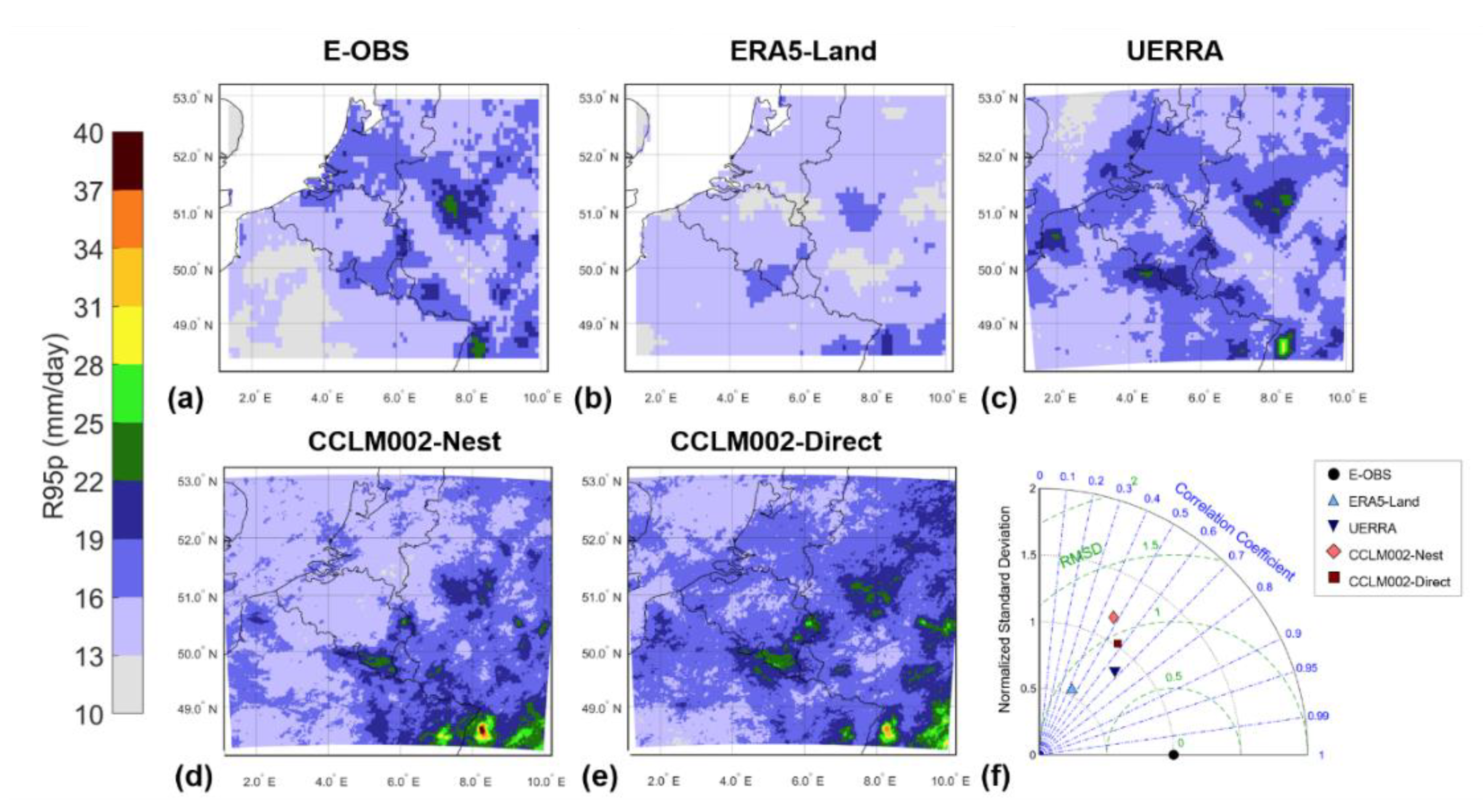
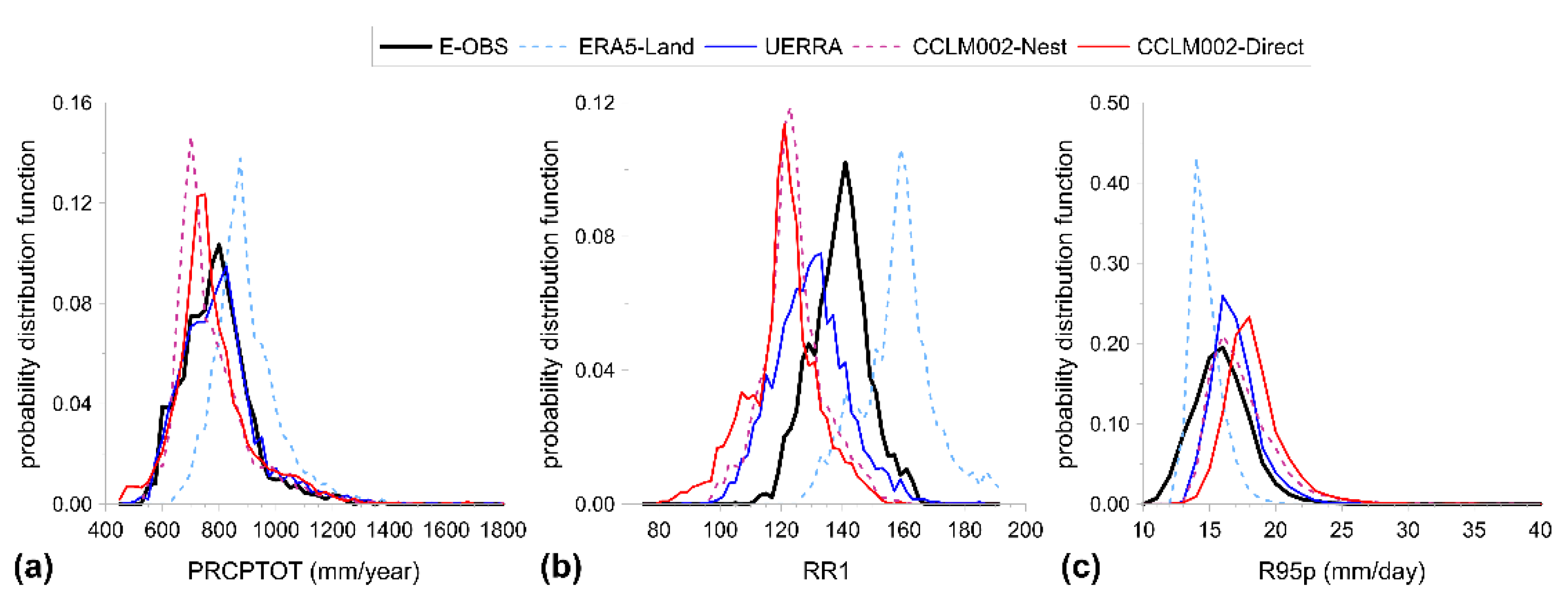
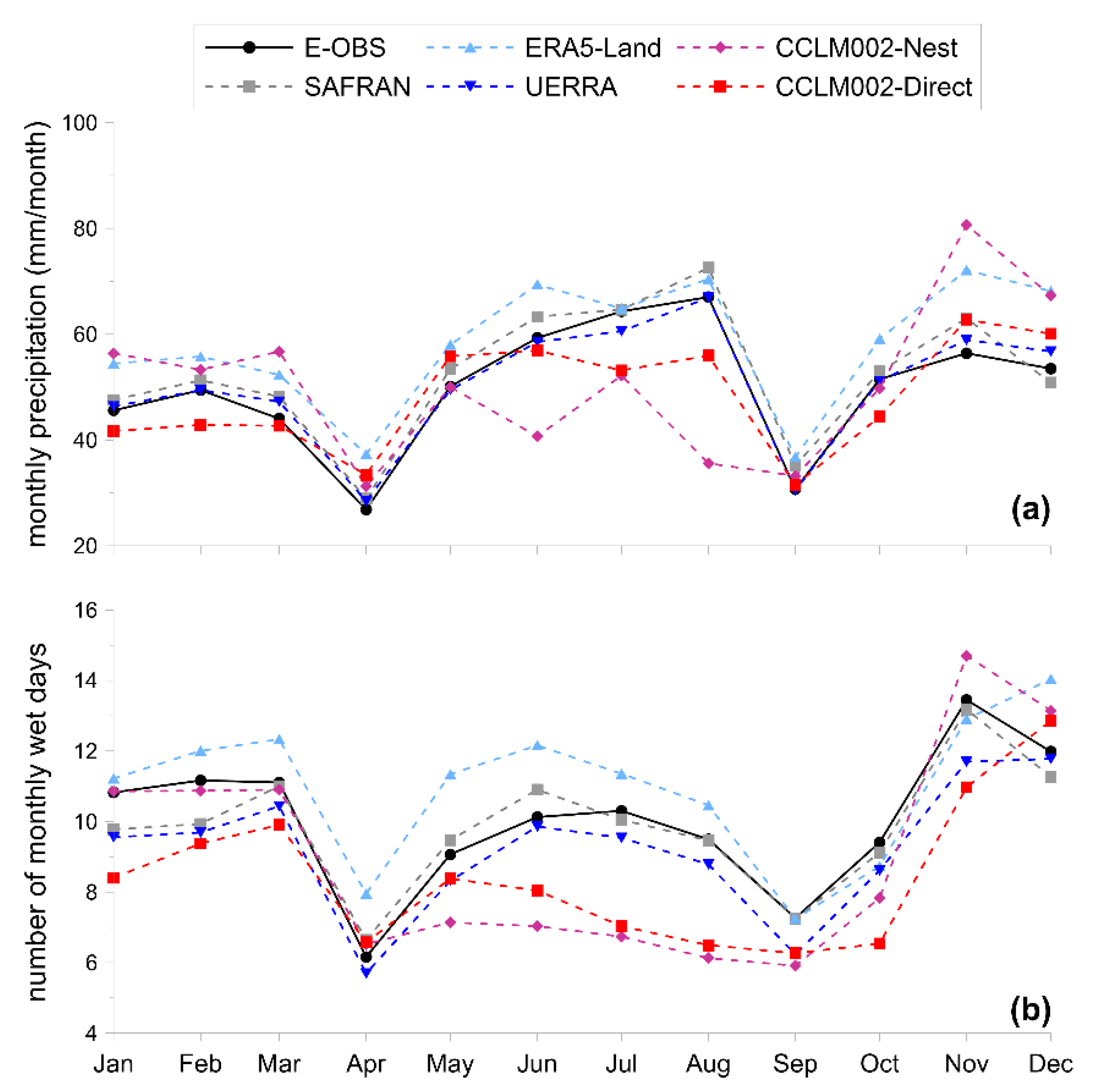
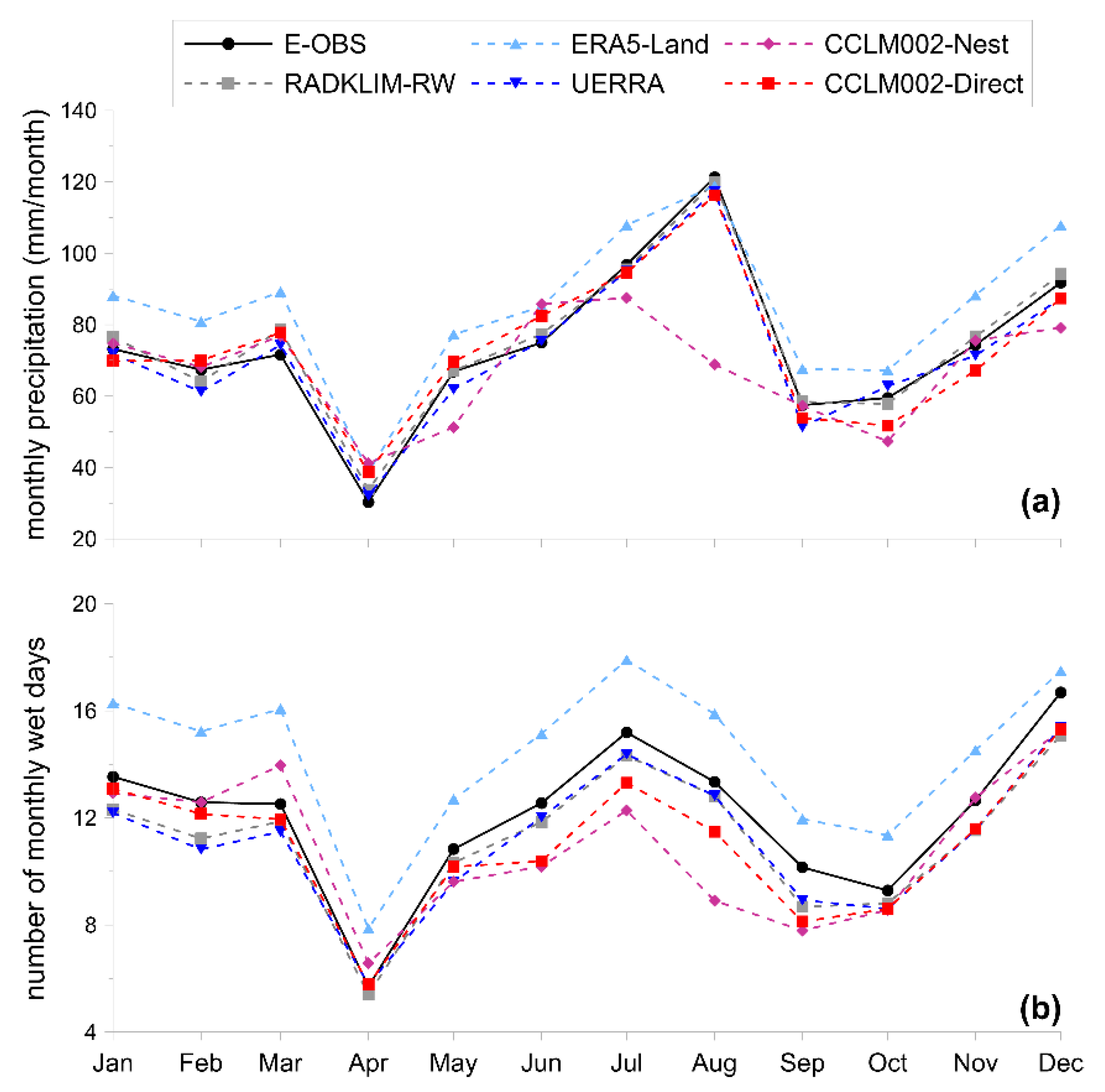
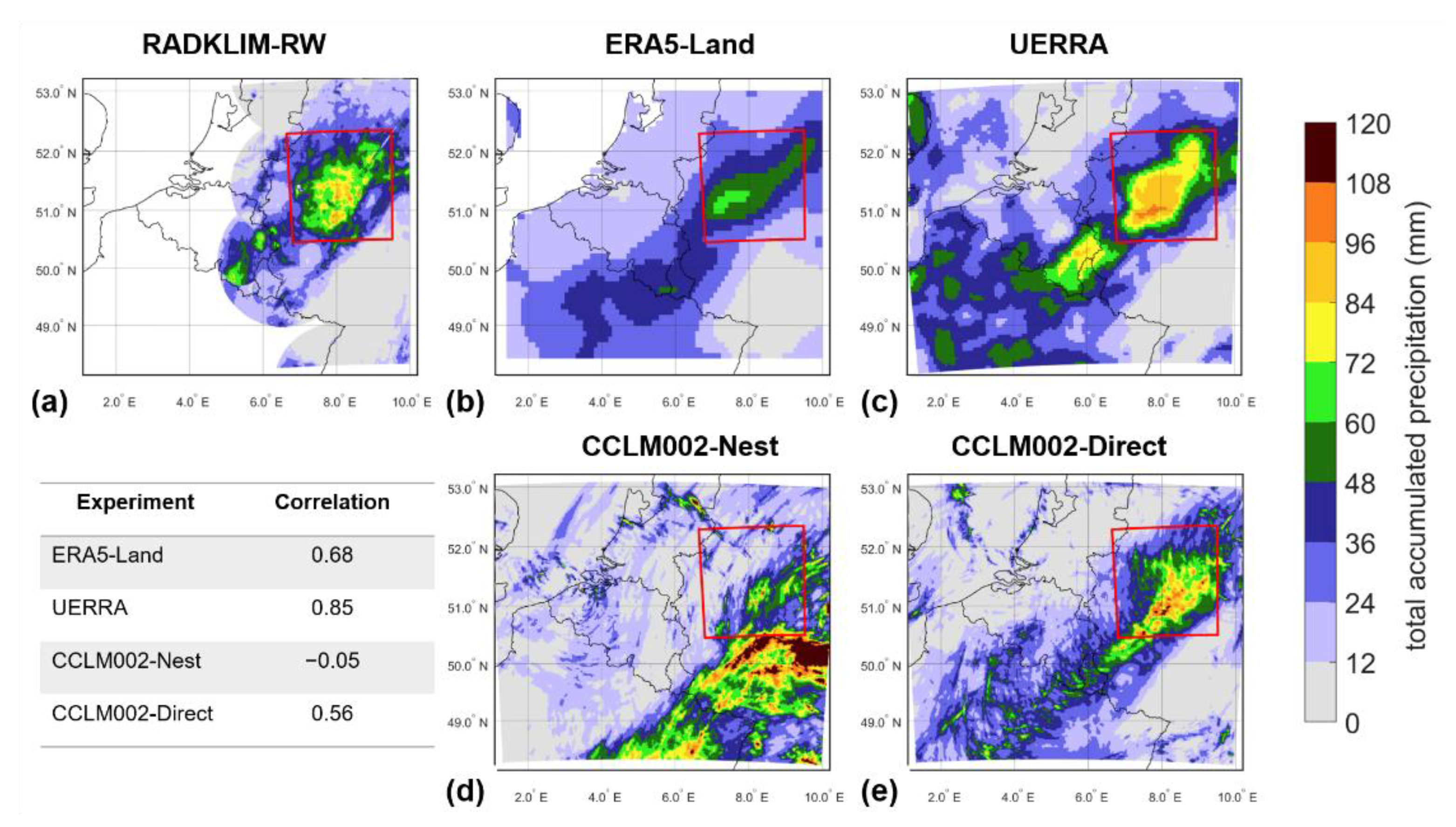
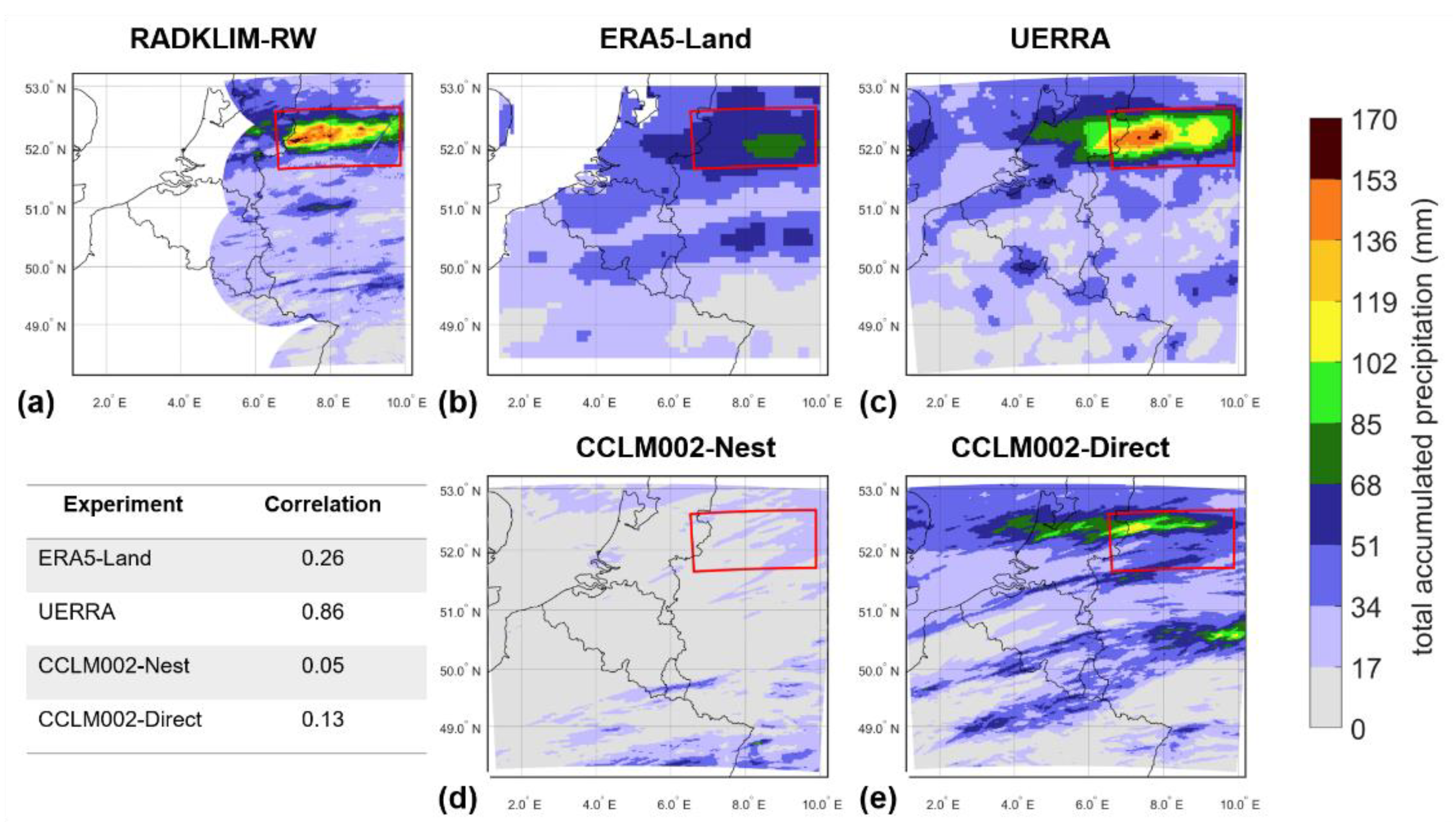
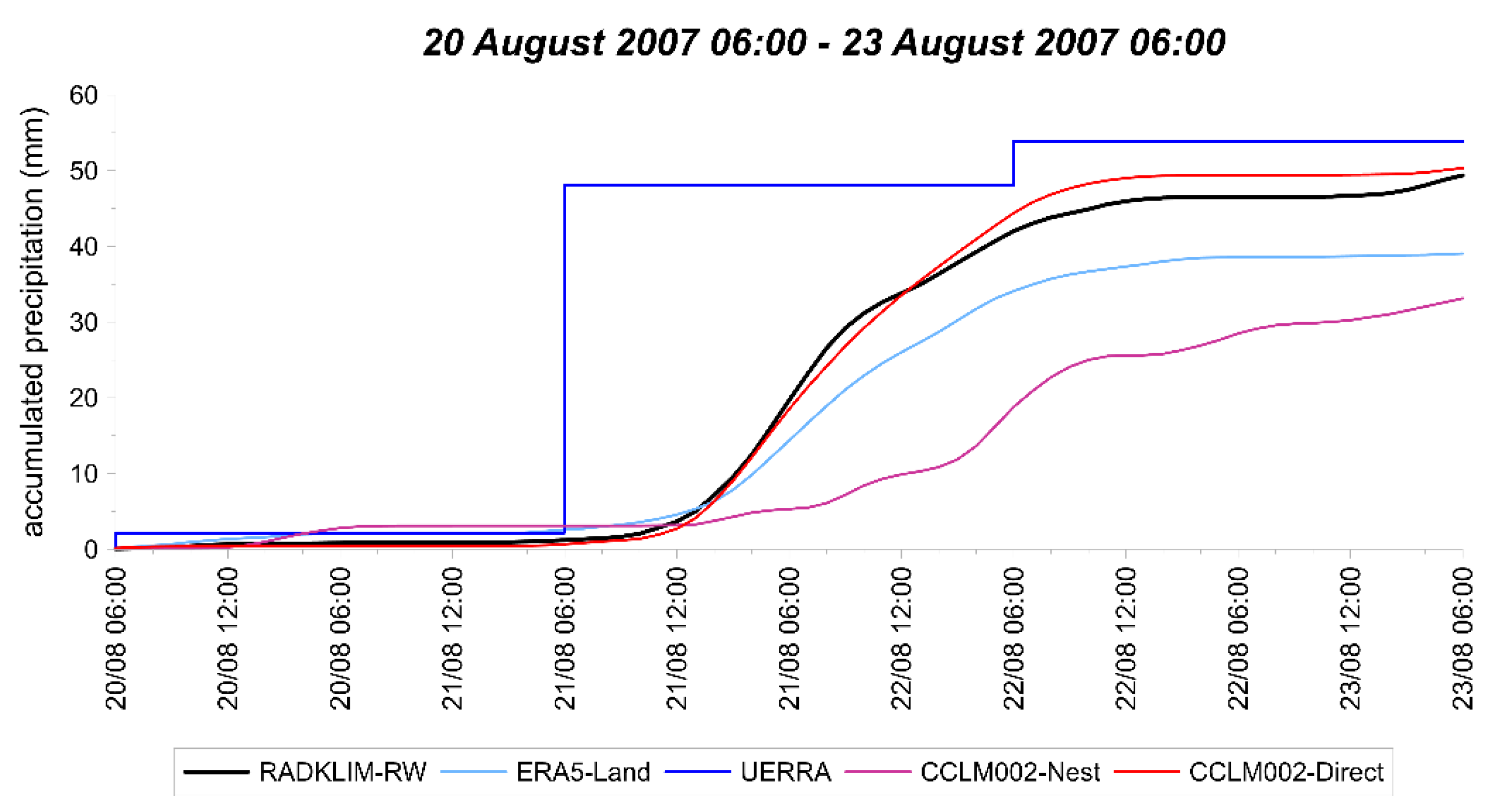
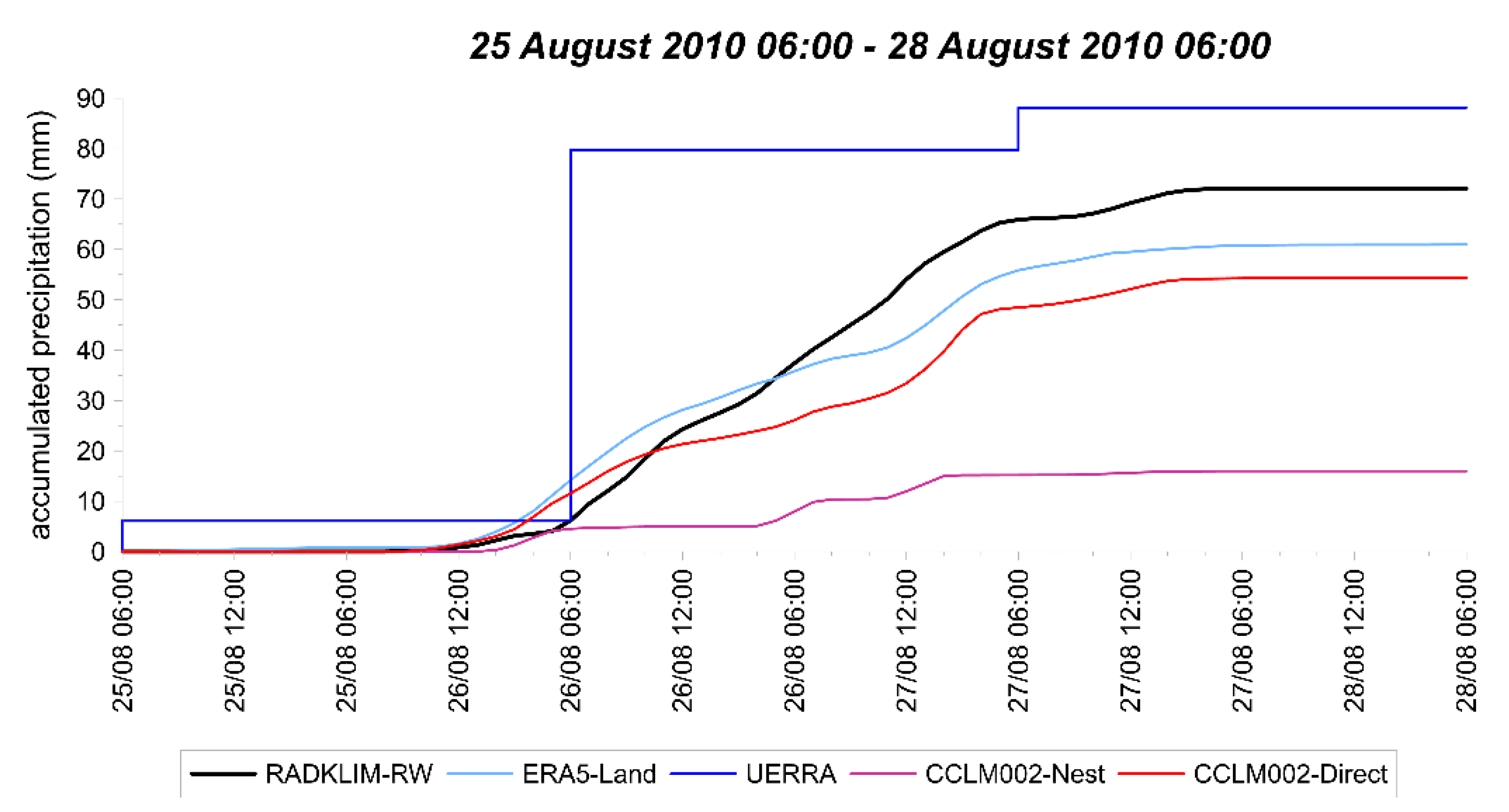
| Model | CCLM011 | CCLM002-Nest | CCLM002-Direct |
|---|---|---|---|
| Boundary forcing | ERA5-Reanalysis | CCLM011 | ERA5-Reanalysis |
| Horizontal resolution | 0.11° (~12 km) | 0.02° (~2.2 km) | 0.02° (~2.2 km) |
| Time step (s) | 75 s | 20 s | 20 s |
| N° grid points | 450 × 438 | 455 × 330 | 455 × 330 |
| N° vertical levels | 40 | 50 | 50 |
| Radiation scheme | Ritter and Geleyn [48] | Ritter and Geleyn [48] | Ritter and Geleyn [48] |
| Convection scheme | Deep and shallow convection based on Tiedtke [49] | Shallow convection based on Tiedtke [49] | Shallow convection based on Tiedtke [49] |
| Microphysics scheme | Doms et al. [50]; Baldauf and Schulz [51] | Doms et al. [50]; Baldauf and Schulz [51] | Doms et al. [50]; Baldauf and Schulz [51] |
| Land surface scheme | TERRA-ML [50] | TERRA-ML [50] with TERRA-URB [42] parametrization | TERRA-ML [50] with TERRA-URB [42] parametrization |
| Land use | GLC2000 [52] | GLC2000 [52] | GLC2000 [52] |
| Planetary boundary layer scheme | Mellor and Yamada [53] | Mellor and Yamada [53] | Mellor and Yamada [53] |
| Lateral Boundary Condition (LBC) update frequency | 1 h | 1 h | 1 h |
| Soil initialization | Temperature and moisture obtained by interpolation from ERA5-Reanalysis | Temperature and moisture obtained by interpolation from CCLM011 | Temperature and moisture obtained by interpolation from ERA5-Reanalysis |
| Indicator | Unit | Description | Areal Scale | City Scale | Event Scale |
|---|---|---|---|---|---|
| PRCPTOT | mm | Total precipitation amount including dry days | X | X | X |
| RR1 | days | Number of days with daily precipitation amount above 1 mm | X | X | |
| R95p | mm | Precipitation amount when daily precipitation exceeds the 95th percentile in wet days (daily precipitation ≥ 1 mm) | X |
| Indicator | CCLM002 Experiment | DAV (ERA5-Land vs. CCLM002) (%) | DAV (UERRA-Land vs. CCLM002) (%) |
|---|---|---|---|
| PRCPTOT | Nest | +29 | −18 |
| Direct | +38 | −12 | |
| RR1 | Nest | +19 | −34 |
| Direct | +4 | −42 | |
| R95p | Nest | +28 | +2 |
| Direct | −11 | −29 |
| City | E-OBS | ERA5-Land | UERRA | CCLM002 |
|---|---|---|---|---|
| Paris | 64 | 64 | 176 | 988 |
| Cologne | 60 | 55 | 130 | 832 |
| City | Indicator | ERA5-Land | UERRA | CCLM002-Nest | CCLM002-Direct |
|---|---|---|---|---|---|
| Paris | PRCPTOT | 0.82 | 0.95 | 0.31 | 0.78 |
| RR1 | 0.84 | 0.89 | 0.45 | 0.72 | |
| Cologne | PRCPTOT | 0.84 | 0.95 | 0.52 | 0.91 |
| RR1 | 0.81 | 0.89 | 0.79 | 0.87 |
| Event | Period | ERA5-Land | UERRA | CCLM002-Nest | CCLM002-Direct |
|---|---|---|---|---|---|
| 1 | August 2007 | 0.64 | N.E. | 0.13 | 0.95 |
| 2 | August 2010 | 0.65 | N.E. | −0.12 | 0.55 |
Publisher’s Note: MDPI stays neutral with regard to jurisdictional claims in published maps and institutional affiliations. |
© 2021 by the authors. Licensee MDPI, Basel, Switzerland. This article is an open access article distributed under the terms and conditions of the Creative Commons Attribution (CC BY) license (http://creativecommons.org/licenses/by/4.0/).
Share and Cite
Raffa, M.; Reder, A.; Adinolfi, M.; Mercogliano, P. A Comparison between One-Step and Two-Step Nesting Strategy in the Dynamical Downscaling of Regional Climate Model COSMO-CLM at 2.2 km Driven by ERA5 Reanalysis. Atmosphere 2021, 12, 260. https://doi.org/10.3390/atmos12020260
Raffa M, Reder A, Adinolfi M, Mercogliano P. A Comparison between One-Step and Two-Step Nesting Strategy in the Dynamical Downscaling of Regional Climate Model COSMO-CLM at 2.2 km Driven by ERA5 Reanalysis. Atmosphere. 2021; 12(2):260. https://doi.org/10.3390/atmos12020260
Chicago/Turabian StyleRaffa, Mario, Alfredo Reder, Marianna Adinolfi, and Paola Mercogliano. 2021. "A Comparison between One-Step and Two-Step Nesting Strategy in the Dynamical Downscaling of Regional Climate Model COSMO-CLM at 2.2 km Driven by ERA5 Reanalysis" Atmosphere 12, no. 2: 260. https://doi.org/10.3390/atmos12020260
APA StyleRaffa, M., Reder, A., Adinolfi, M., & Mercogliano, P. (2021). A Comparison between One-Step and Two-Step Nesting Strategy in the Dynamical Downscaling of Regional Climate Model COSMO-CLM at 2.2 km Driven by ERA5 Reanalysis. Atmosphere, 12(2), 260. https://doi.org/10.3390/atmos12020260








